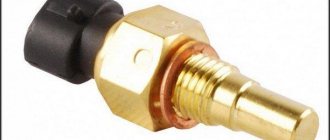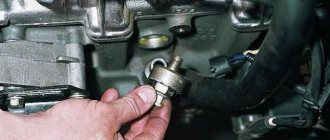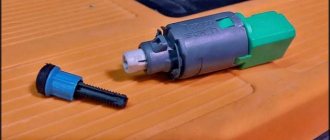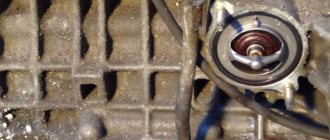Injection system
Nowadays, cars have become more advanced and technologically advanced. The control process from a carburetor engine switched to an injection engine. A car engine injector is much more reliable than a carburetor.
The injection system will allow you to more correctly control the car engine, which allows you to use fuel more economically. Modern cars are equipped only with injection engines, since using a carburetor engine is not advisable.
The injection system uses a large number of different sensors that send signals to the electronic engine control unit. Since the injection system uses a large number of sensors, they often fail. This is due to aging or improper operation of the car.
In this article we will talk about all the sensors installed on Lada cars, what role they play and what they are needed for.
Preparatory stage
Before you start, you should do the following:
- choose and buy a suitable cooler;
- stock up on a new cover mount in case the old one is damaged;
- take the wrench;
- find a container where you will send the waste liquid;
- buy rags.
Algorithm of actions
To replace antifreeze in Priora, follow the instructions:
- Send the car to a garage with plenty of free space to work on. Cool down the engine. All actions must be performed on a cold engine system.
- Get rid of high blood pressure. Open the cap of the reservoir containing the antifreeze. If the engine is hot, fluid may splash out. Use a cloth and gloves for protection.
- Remove the protection that is installed on the propulsion system. Unscrew the bolts on the mount. The latches do not need to be removed. They will not interfere with the process.
- If a transmission with cables is installed, it must be removed. To do this, disconnect power from the battery. Remove the protective coating with a wrench.
- Now you need to drain the entire volume of liquid. To do this, unscrew the fixing cap. Place a container below where the waste material will be drained. Wait until all the refrigerant has left the tank. Assess the condition of the latch. If signs of wear are noticeable, replacement is recommended.
- If there are any cloudy traces in the coolant, it is recommended to flush all the channels in the car. To do this, add purified water. Add citric acid or vinegar to remove any remaining dirt. Flush the system until the water runs clear. Only after this can you fill the coolant into the tank.
- Assess the condition of the hoses. If they are worn out, replace them.
- Using a hose, pour new fluid into the container. Avoid high internal pressure.
- Refrigerant is added until the tank is filled to the optimum level.
- All disassembled parts are reassembled in reverse order.
- Start the engine and take it for a test drive. After this, check if all systems are normal.
Mass air flow sensor
The mass air flow sensor, also known as mass air flow sensor, is installed on all fuel-injected Lada and VAZ cars. The sensor is located between the intake receiver bellows and the air filter box. This sensor is involved in the process of forming the fuel-air mixture. It also estimates the amount of intake air, taking into account its temperature. If there is a malfunction, the “CheckEngine” light does not always light up.
Signs of sensor malfunction:
- Loss of vehicle dynamics;
- Unstable idle;
- Jerking when moving;
- Difficulty starting the engine;
- High fuel consumption;
Checking the water heater safety valve
The safety valve is an important part in the operation of the water heater.
You can check the operation of the safety valve as follows:
- First you need to turn on the water heater and make sure that the hot water supply tap is not open until the water is heated to its maximum. If the valve is working properly, excess water should begin to drip through it.
- If water does not drip from the valve, then most likely it is faulty and will have to be replaced.
Do not proceed with replacement without checking the hot water tap. It should not leak, since excess water can leak through it, and therefore the valve will not work.
The valve may not work if the thermostat is installed incorrectly, namely for incomplete heating of the water, and also if water is drawn from the water heater, which reduces the pressure in it.
Speed sensor
The speed sensor is installed on the gearbox housing and is designed to measure the speed of the vehicle and calculate the kilometers traveled. The speed sensor also provides readings for preparing the air-fuel mixture while the car is moving. You can notice that when the car is rolling at neutral speed, the idle speed is slightly higher than when the car is stationary. When there is a malfunction, the “CheckEngine” light almost always comes on.
Signs of sensor malfunction:
- There are no increased speeds when driving at neutral speed;
- Speedometer does not show speed;
- The odometer does not work;
- EUR does not work;
How to check
There are two options for checking the functionality of the sensor:
- With the need to remove;
- With thermometer;
- Without thermometer;
- Right on the spot, without taking off.
But first you need to make sure that the sensor is receiving power. Remove the chip from the DTOZH and measure the DC voltage with a multimeter. It should be about 5 V. If it is approximately within these limits, we check further.
Without removing the sensor, you can check its performance in the following way. We disconnect the chip. We measure the resistance between the sensor contacts. When the engine is cold, the resistance will be higher, and when the engine is hot, it will be lower. For example, let's give a data table for the VAZ-2110 car. For other cars that use similar sensors, the numbers will be approximately the same.
| See all advertisements in the archive |
| Water temperature, °C | Resistance value, Ohm | Water temperature, °C | Resistance value, Ohm |
| +5 | 7280 | +45 | 1188 |
| +10 | 5670 | +50 | 973 |
| +15 | 4450 | +60 | 667 |
| +20 | 3520 | +70 | 467 |
| +25 | 2796 | +80 | 332 |
| +30 | 2238 | +90 | 241 |
| +40 | 1459 | +100 | 177 |
To remove the sensor, a simple wrench will be enough. After removing it, you need to take several measurements with water of different temperatures. We heated the water and poured it into a glass. We also lower the thermometer and sensor there. More precisely, its sensitive element. We connect the multimeter probes to the electrical contacts. We measure the water temperature and sensor resistance. We record the data. Then we heat the water a little more and repeat all the steps. And so several times, for example, record the indicators at a temperature of +15 °C, +20 °C, +25 °C and so on. And then just compare these numbers with the numbers in the table above. But it’s better with technical documentation.
How to test the sensor for damage without using a thermometer? We do the same thing, but bring the water to a boil. And, referring to the table above, the sensor resistance should be ~177 Ohms. Of course, errors are possible here, since while you are getting ready to take measurements, the water will be a couple of degrees colder, which means the resistance will be a little less. This is also worth considering.
If the sensor gives you very different numbers, urgently replace it.
Coolant temperature sensor
Coolant temperature sensor, also known as DTOZH. Installed in the thermostat housing. Serves to prepare the air-fuel mixture when starting the engine. It also simultaneously displays coolant temperature readings on the car’s dashboard and turns on the engine cooling fan. If there is a malfunction, the “CheckEngine” light does not light up.
Signs of sensor malfunction:
- Loss of vehicle dynamics;
- Unstable idle;
- Jerking when moving;
- Difficulty starting the engine;
- High fuel consumption;
- Difficulty starting in the cold season;
Crankshaft position sensor
Crankshaft position sensor, also known as DPKV. Installed on a bracket near the generator belt drive pulley. Works on the law of electromagnetic induction. Reads readings from the crown of the generator drive pulley. Sets the ignition timing angle (IAF). If there is a malfunction, the “CheckEngine” light comes on.
Signs of malfunction:
- The engine runs intermittently;
- The engine does not start (no spark);
Phase sensor
The phase sensor is installed on an engine with 16 valves, located near the fuel rail. Based on the law of electromagnetic induction, it takes readings from the intake camshaft master pulley. Participates in the process of formation of the air-fuel mixture for each cylinder separately. In the event of a malfunction, the engine begins to operate in emergency mode. When there is a malfunction, the “CheckEngine” light almost always comes on.
Signs of malfunction:
- The engine runs intermittently;
- Increased fuel consumption;
- Unstable engine operation at idle;
The principle of operation of the adsorber on Priora
The breather is a container filled with activated carbon. Two hoses extend from it - outlet and inlet, and it itself is part of the engine power system. It operates like any storage tank: when gasoline vapors rise through the tubes from the gas tank, some of them manage to turn into liquid and flow down to the gas tank.
The second part of the vapor enters the inlet tube of the absorber and remains inside the container. They condense because activated carbon acts as a catalyst for the operation. The process occurs with the engine turned off - while the power system is at rest. After this, the fuel will be used by the engine.
The absorber valve, which operates on the principle of electromagnetic induction, is responsible for the release of fuel in the Lada Priora. The causes of malfunctions can be eliminated by simply replacing the Priora adsorber purge solenoid valve. A special absorber sensor is responsible for its movements. Like any other part that performs similar functions, it is critical to maintaining the functionality of the automotive system.
The ECU independently controls many of the processes taking place under the hood. Among his responsibilities is the preparation of the fuel-air mixture with the correct proportion. This means that the ECU must correctly use the available resources (fuel) by connecting the breather to work.
Idle speed control
The idle speed regulator, also known as IAC, is installed in the throttle valve. Designed to regulate idle speed on engines without the E-GAS system. The sensor is quite unreliable and fails very often. It is a motor with a worm gear. If there is a malfunction, the “CheckEngine” light does not light up.
Signs of malfunction:
- Not smooth idle;
- The revolutions are floating;
- Troubles the engine;
How to make a replacement yourself
Replacement of the Lada Priora DTOZH is carried out only after the preparatory work described above. For this purpose, disconnect the wires from the part along with the terminal and unscrew it. The most convenient way to do this is to use a 19 mm deep socket. As soon as the sensor begins to give in, it is unscrewed and removed manually.
Sequence of actions when replacing a temperature detector:
- Find the negative wire and remove it from the battery;
- A little antifreeze needs to be drained;
- Press out the plastic clips;
- Disconnect the wires;
- Loosen the tension a little and carefully unscrew it;
- Replace the sensor and perform all steps in reverse order.
- Add antifreeze back.
Change this spare part at least once, and it will become clear that the procedure does not present any particular difficulties.
Throttle Position Sensor
The throttle position sensor (TPS) is installed on the throttle valve on cars without the E-GAZ system. Designed to regulate engine speed. The sensor is not reliable and often fails. If there is a malfunction, the “CheckEngine” light does not always light up.
Signs of malfunction:
- Not smooth idle;
- The revolutions are floating;
- Troubles the engine;
- When starting the engine, the speed is increased;
- Spontaneous increase or decrease in speed;
Oil pressure sensor
The oil pressure sensor is installed in the cylinder head. Designed to indicate oil pressure and indicate oil pressure when the engine is running. A very reliable sensor that rarely fails. The “CheckEngine” light does not light up when there is a malfunction.
Signs of malfunction:
- The oil pressure light is constantly on;
- The oil pressure light does not light up when the ignition is turned on;
What are the dangers of a faulty valve?
Incorrect operation of the adsorber and its entire system will sooner or later lead to the fact that the fuel tank will no longer be ventilated with proper regularity. Next, a vacuum occurs, after which deformation and damage to the pump usually occurs.
When there is no ventilation of the device in question on the Lada Priora, gasoline begins to accumulate in the intake manifold. This will lead to engine malfunctions. The spark plugs become clogged, the catalyst and a device such as a lambda probe fail.
Oxygen sensor
The oxygen sensor is installed in the exhaust manifold of the car. Serves to monitor exhaust gases and adjust the air-fuel mixture. A reliable sensor rarely fails. If there is a malfunction, the “CheckEngine” light does not always light up.
Signs of sensor malfunction:
- Loss of vehicle dynamics;
- Unstable idle;
- Jerking when moving;
- Difficulty starting the engine;
- High fuel consumption;
- Black smoke when driving at high speeds;
Where to buy car accessories
Spare parts and other products for the car are easily available for purchase at auto stores in your city. But there is another option that has recently received significant improvements. You no longer need to wait a long time for a parcel from China: the AliExpress online store now offers the opportunity to ship from transshipment warehouses located in various countries. For example, when ordering, you can specify the “Delivery from the Russian Federation” option.
Follow the links and choose:
| Eunavi 12V universal car auto door lock | YASOKRO car parking sensor, parking sensor system with 4 sensors | Car windshield projector GEYIREN M8 |
| Parking assistance system GSPSCN | Car Rear View Mirror 4.3 inch CCD | Radar detector, voice notification, 360 |
Knock sensor
The knock sensor is installed on the cylinder block under the intake receiver. Based on the principle of the piezo element. Engine detonation is measured and the air-fuel mixture is adjusted. Quite a reliable sensor. If there is a malfunction, “CheckEngine” does not light up.
Signs of sensor malfunction:
- Loss of vehicle dynamics;
- Unstable idle;
- Jerking when moving;
Air conditioner sensor
The air conditioning sensor is installed under the bumper next to the air temperature sensor. Designed to turn on the air conditioner or protect against turning on at low temperatures. Let us remind you that the air conditioning in Lada cars only works at outside air temperatures of +5 degrees. Reliable sensor, no breakdowns were detected.
Signs of malfunction:
- The air conditioner clutch does not engage;
Mechanical engineering keeps up with the times, so new sensors appear quite quickly in car engine control.
Checking the regulator for functionality
To diagnose DTOZH at home, you will need a separate container with antifreeze, as well as a thermometer that can record temperatures up to 120 degrees. Checking is carried out using a tester. In particular, you need to measure the resistance at different temperatures of the liquid (the liquid must be heated during diagnostics), and the obtained data is checked against the temperature.
At 100 degrees, the resistance of the device should be 177 ohms, at 90 degrees - 241 ohms, at 80 - 332 ohms. At an engine temperature of 0 degrees, the resistance level will be 7280 Ohms, at 40 degrees - 1459 Ohms. This data will be sufficient for diagnostics.











